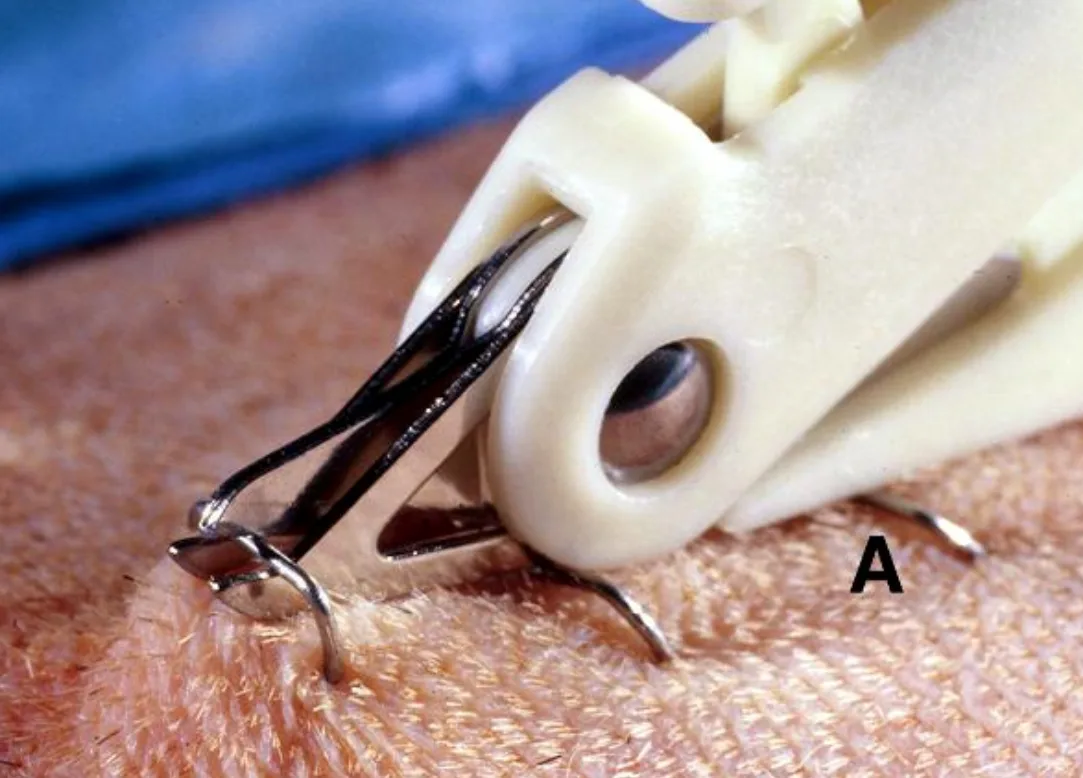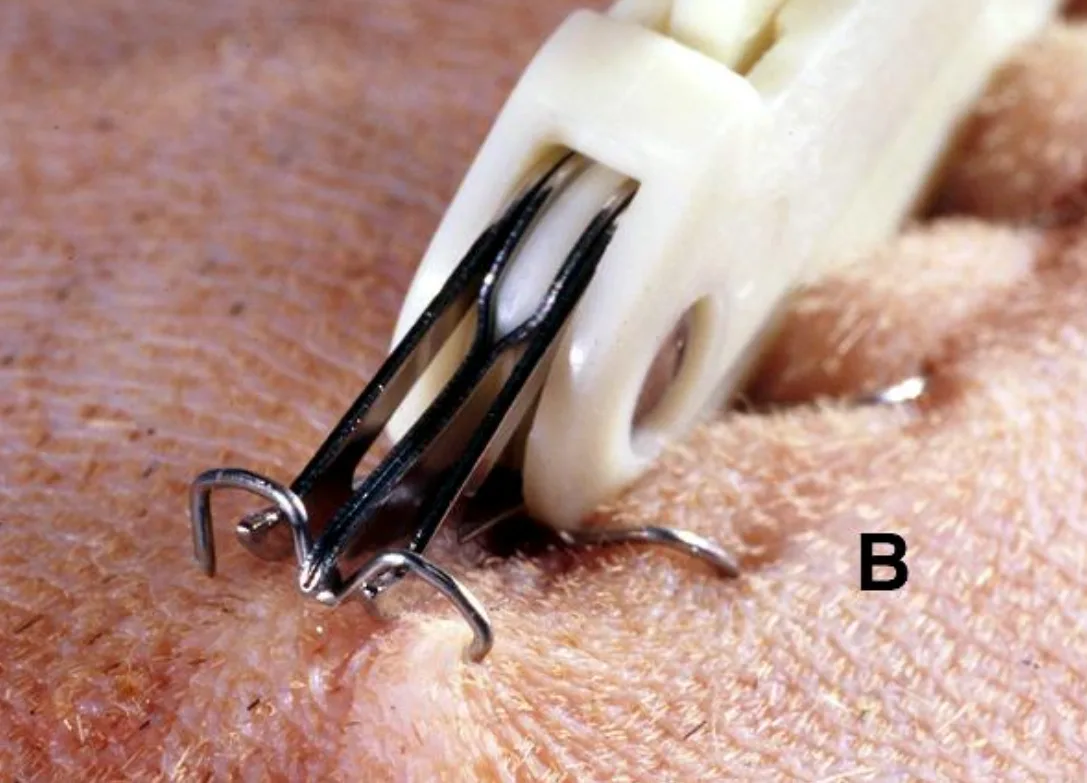Skin Stapling
Daniel D. Smeak, DVM, DACVS, Colorado State University
Overview
Mechanical methods of skin closure were developed as early as the mid 1950s.1 Sterile, disposable staplers, similar to the ones we use today, became commercially available for wound closure in humans in the early 1970s. Now, a wide variety of staplers are available, and competition among manufacturers has reduced costs, making them attractive to veterinarians. Skin stapling has become an acceptable, affordable alternative to traditional, hand-sewn skin closure in small animals.2 Clinical features of the various fixed-head skin staplers have been compared, and the choice of model is largely left up to surgeon preference and price.2 This article will briefly discuss staple use, with a focus on closure of skin wounds with staples.
Skin Staplers: Clinical Applications
Skin staplers are primarily used to appose the edges of skin wounds, but they have other applications. For example, they can provide a fixed grasping point for manipulating skin flaps during reconstruction to reduce trauma from repeated use of thumb forceps as well as a means of retraction by fixing loose skin edges away to allow unrestricted deeper wound dissection. Staplers can also be successfully used to fasten skin grafts to recipient beds, to attach secondary wound barriers-such as stockinet or adhesive drapes-around skin wounds to reduce exposure and contamination, for catheter fixation,3 as tie-over fixation of bandages over wounds,4 to close intestinal wounds5 and fasten the muscular flap in belt-loop gastropexy,6 to secure mesh in hernia repairs,7 and as a means of abdominal fascial closure.8
Types of Staplers-Pinch or Grip?
Disposable skin staplers can be divided into two groups by the type of grip: Pinch staplers (Figure A) and palm-grip staplers (Figure B). Pinch staplers are fired by pressing the thumb and index finger together and are less expensive but more difficult to control than palm-grip staplers. Thus, they are less popular. Palm-grip staplers are the most widely used type in small animal surgery. These staplers are discussed here to demonstrate stapled skin apposition; however, technique is generally similar regardless of the type of stapler.
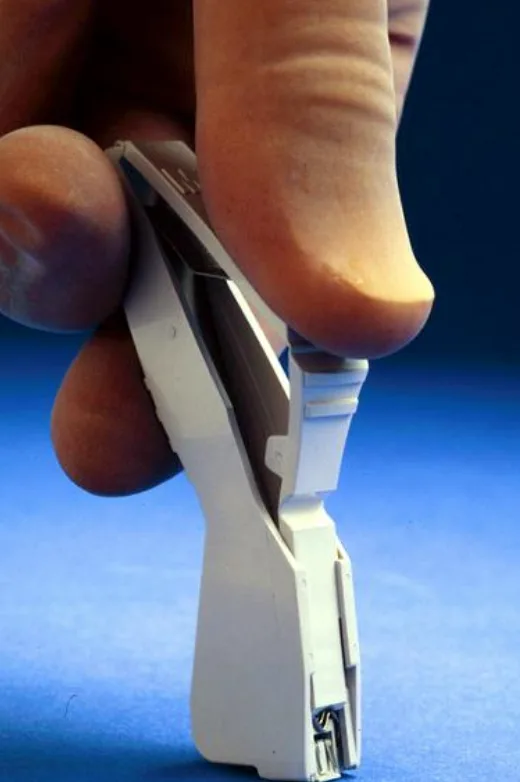
A
Staples or Sutures?
Hand-suturing skin wounds is known to be more time-consuming than skin stapling, particularly for long incisions. Unlike staples, however, stitches can be placed to correct poorly apposed skin edges, such as vertically "stair-stepped" wounds or any wound in which it is difficult to establish apposition. In addition, staples are less secure than sutures, particularly when there is residual extrinsic tension and in patients with thin skin.2 No major differences in overall clinical results have been found in stapled wounds compared with those closed by percutaneous sutures or intradermal methods.9-13
Thumb or Forceps
No special equipment is required for skin closure with staplers. Unique thumb forceps have been designed to help evert skin edges during staple application. The Lalonde forceps (Figure C), which have hooked points, and the Jess forceps (Figure D), which have an angled set of teeth, are used to purchase both sides of the wound at once. This enables a staple to be placed just adjacent to the forceps (Figure E). These forceps are particularly useful if the skin is not well apposed or if it has inverted after subcutaneous closure.
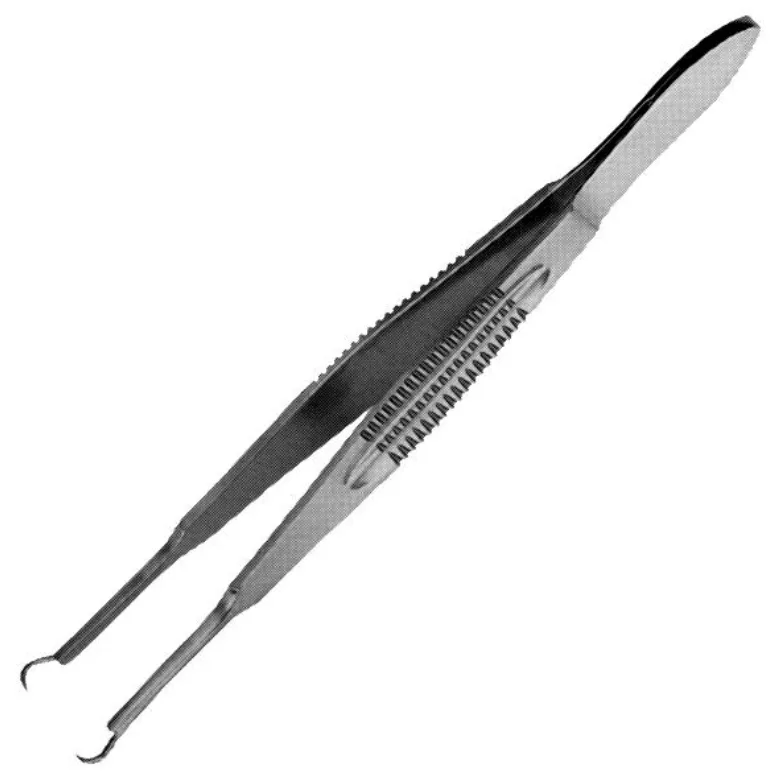
C
Step-by-Step: Wound Closure
Step 1
Eliminate skin tension; create apposition. If skin edges are not well apposed or invert at the time of stapling, the staple will not correct these problems (Figure 1A). If an assistant is available (and subcutaneous sutures are not necessary or wound edges are not apposed even after subcutaneous sutures are placed), the assistant can help relieve skin tension by pushing loose skin toward the incision or gently grasping and everting wound edges with thumb forceps. Another technique is to lift and place apposing tension on the skin edges using two towel forceps placed at the ends of the incision (Figures 1B and 1C). The latter technique is found to be overly traumatic by some, but I find it less so than thumb forceps. When no assistant is available and skin edges are not aligned properly after subcutaneous soft tissue closure, use special thumb forceps held in the nondominant hand to achieve a cosmetic result.14
First, grasp the skin with the forceps, keeping the skin in slight eversion, and apply a staple just adjacent to the tips of the forceps (Figure 1D). Without releasing the stapler grip, release the forceps and pull the stapler slightly away from the wound, bringing the skin edges closer for stapling (Figure 1E). This allows the forceps to regrasp the edges of the wound at the next position to place the staple (Figure 1F). Release the staple, and reposition the stapler at the tips of the forceps as before. Apply the next staple as shown in Figure 1D. Repeat the process until the wound is closed.
Procedure Pearl
For the most secure and cosmetic staple closure, attempt to eliminate skin tension and bring skin edges as close to approximation as possible with proper subcutaneous sutures.
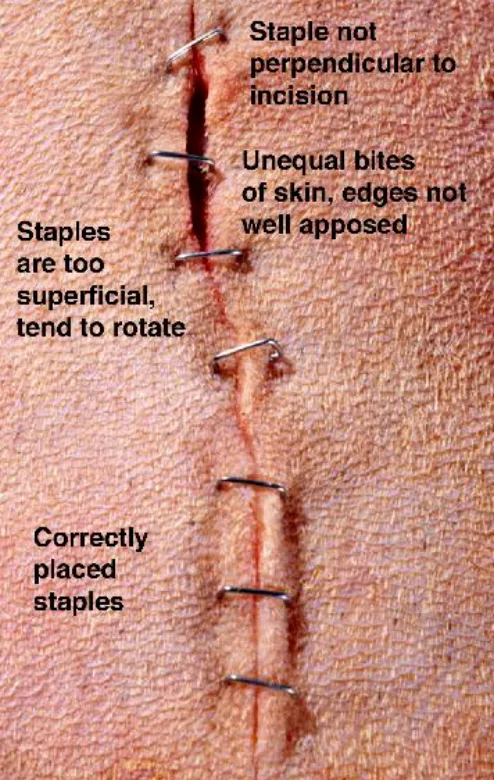
FIGURE 1A
Step 2
Establish proper stapler alignment. If the stapler has a precock mechanism (Figure 2A), staple arms are exposed at the stapler head to allow fine adjustment in staple alignment. Once the stapler is in the correct position, squeeze the trigger handle until the staple arm is visible and the trigger is fully depressed. Alternately, if the stapler does not have a precocking mechanism, position the arrow or stapler head so the staple will purchase both skin edges equally and the staple will be placed perpendicular to the skin edges. Position the stapler such that the line of completed staples can be viewed as the staples are applied. If at all possible, a right-handed surgeon should apply the staples from right to left-otherwise, the distance between the staples cannot be judged since the hand and stapler body obstruct the surgeon's view of the stapled line, potentially resulting in a haphazard arrangement.
Procedure Pearl
Carefully align the stapler head so that the staple is applied equidistant from the previous several staples, purchase equal bites of skin on either side of the incision, and apply staples perpendicular to the incision line.
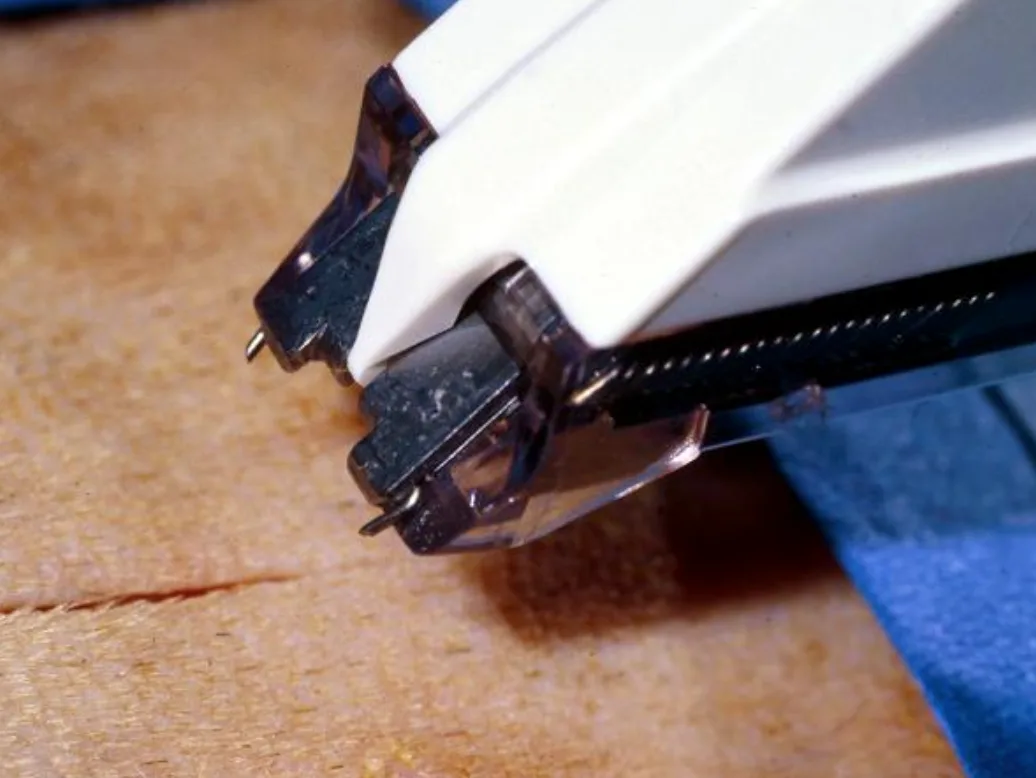
Step 3
Space the staples consistently. Use the fewest number of staples possible to close the wound and ensure apposition. In humans, it has been suggested that optimal wound perfusion is attained when staples are spaced 6 mm or more apart.10 Similar studies have not been done in companion animals; however, this author agrees with that recommendation.
Step 4
Apply the staple correctly. Position the stapler horizontally (if a palm-grip stapler is used), so that the stapler head and wound edges can be seen during stapling. The angle of the stapler can be varied to view the wound edges without affecting stapler performance.
Put just enough pressure on the stapler head. Too much pressure may incorporate important structures into the incision (especially if there is little subcutaneous fat in the area); not enough pressure may result in a superficial closure that does not appose the wound edges. In addition, a superficial staple rotates more easily (especially in areas of thin skin) and may result in premature staple loss, causing wound disruption (Figure 4A). Ideally, the visible part of the staple should ride just off the wound surface. Using consistent pressure during staple application is perhaps the hardest part of the technique to master.
Ensure that the staple has been applied correctly by checking for rotation or improper alignment. Remove any skewed staples and correct the problem before applying a new staple.
Once the staple has been applied, most staplers have an automatic release mechanism that separates the staple from the stapler as the handle is released. Attempt to space all staples equally and maintain consistent alignment while closing the remaining wound edges.

Procedure Pearl
Remember, staples can only be expected to hold skin edges in the exact position established at the time the staple gun is fired: They do not bring edges into apposition.
Staple Extraction
Reposition any rotated or buried staples so the base of the staple spanning the wound is visible. Partially open the jaws of the staple remover, and slide the bottom jaw completely under the exposed portion of the staple (Figure A). Close the jaws, which kinks the staple and separates the staple points, allowing the staple to be removed without discomfort to the patient (Figure B).
